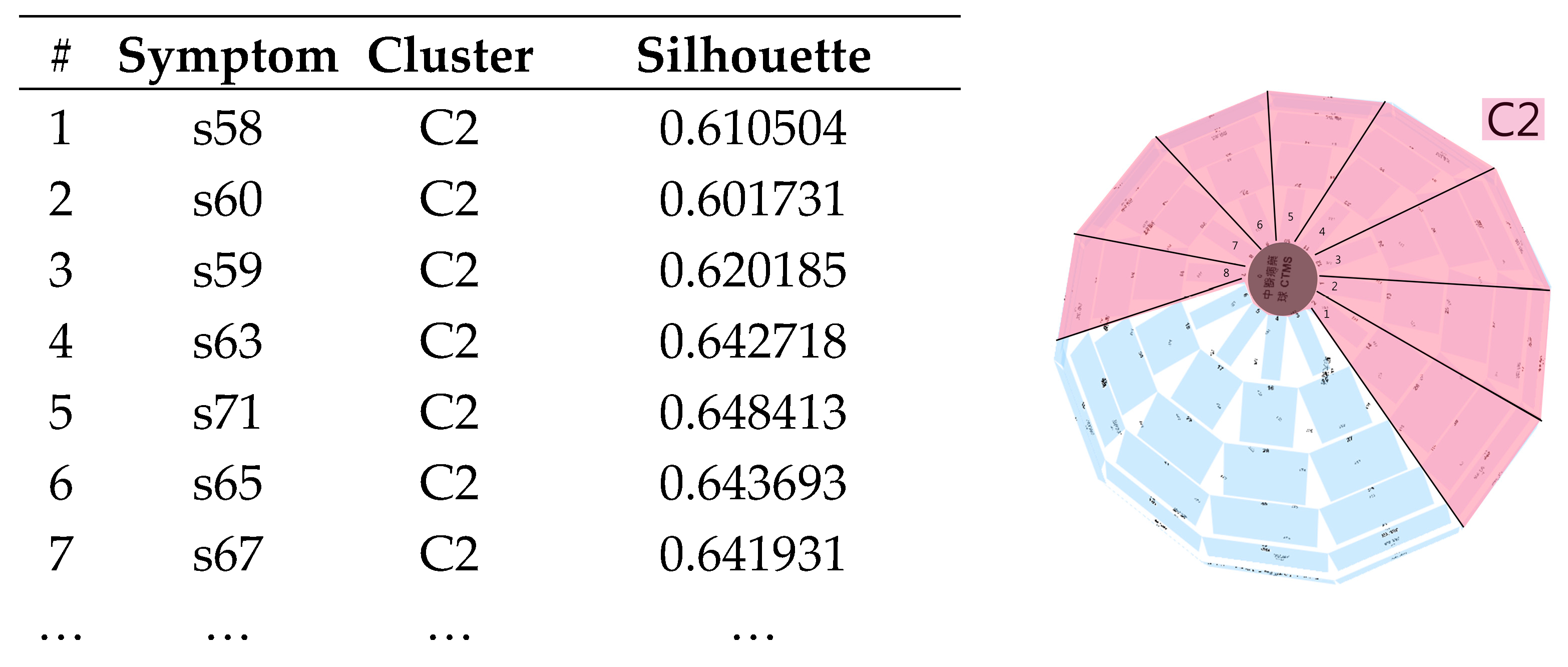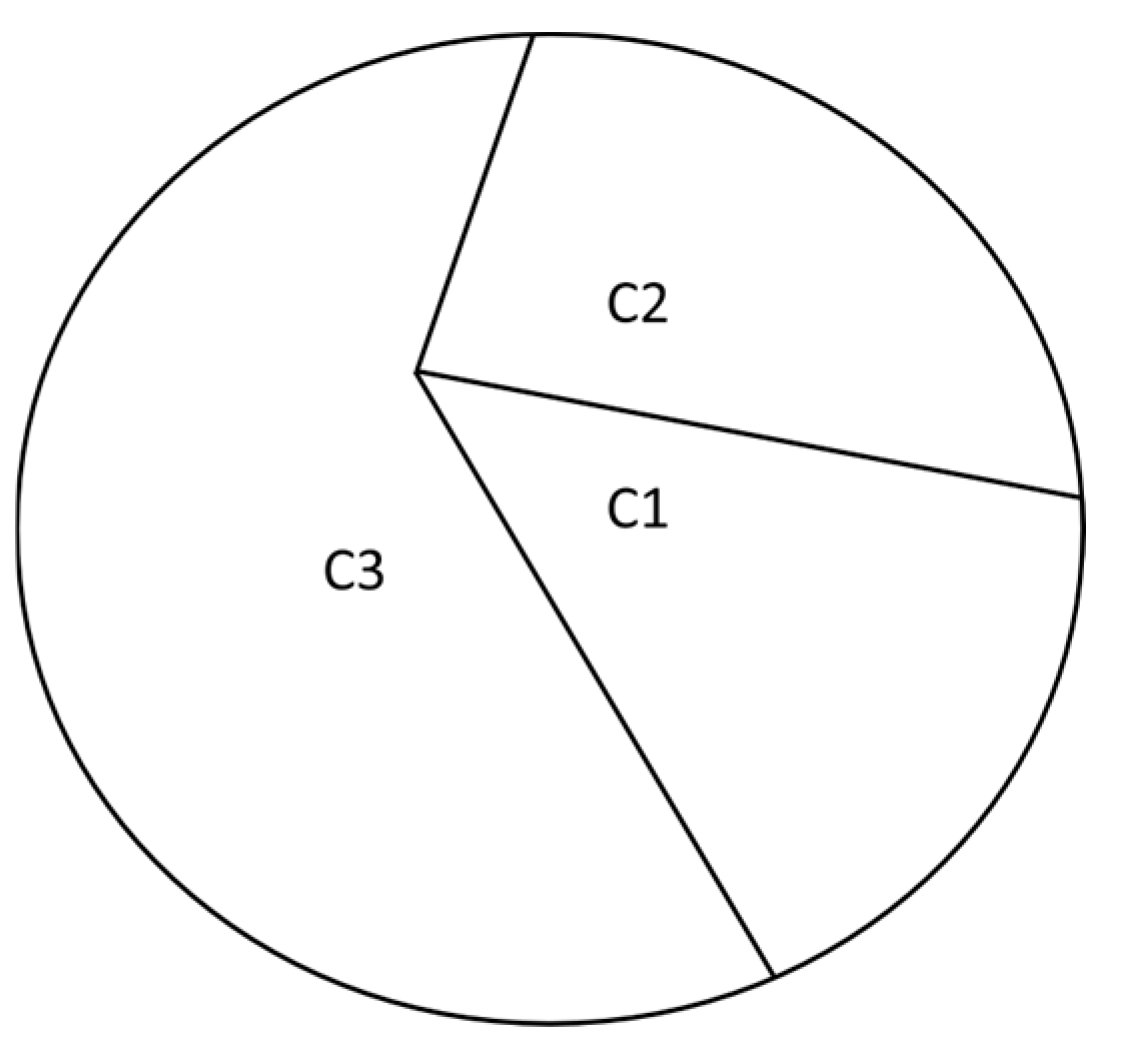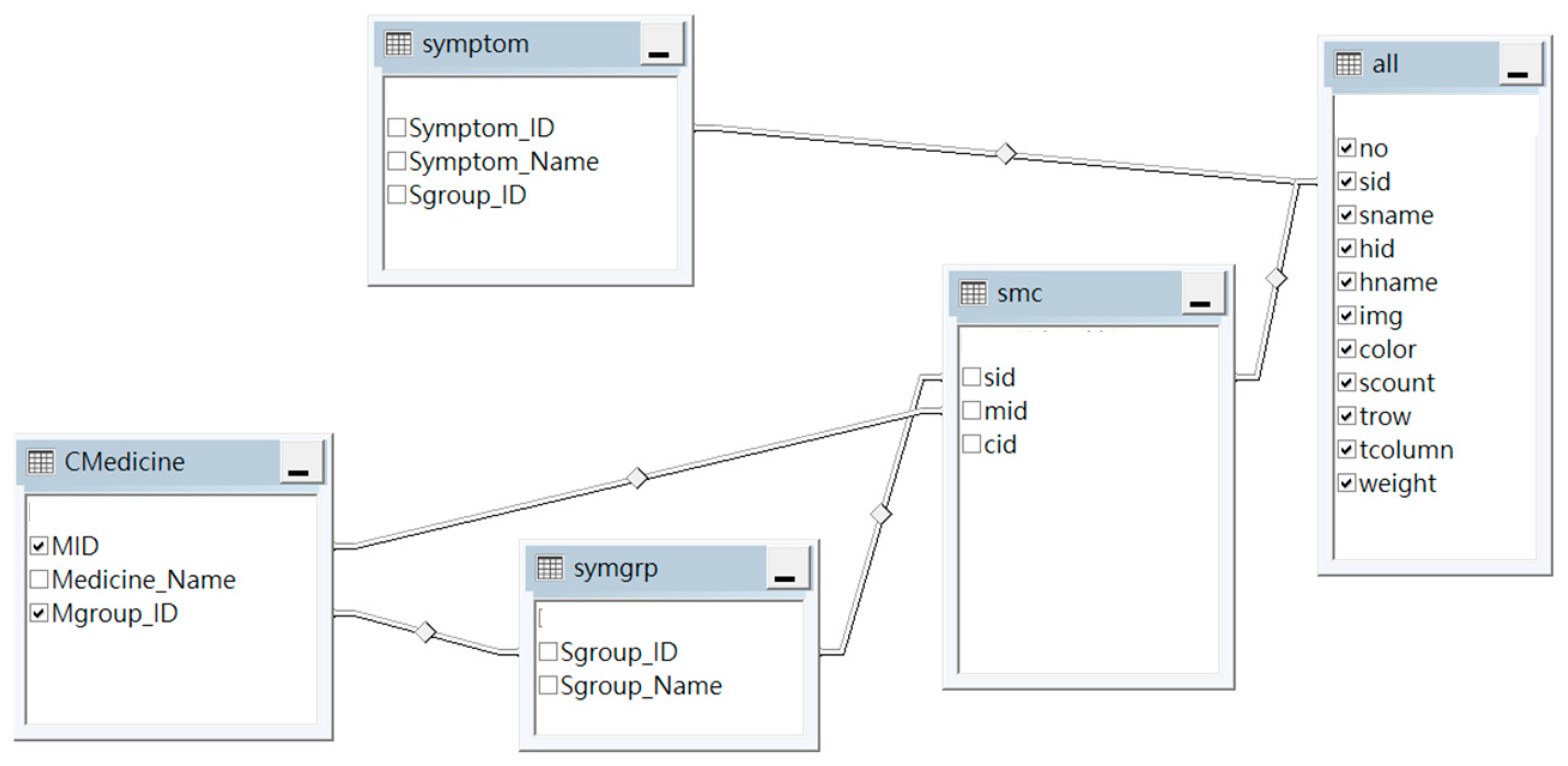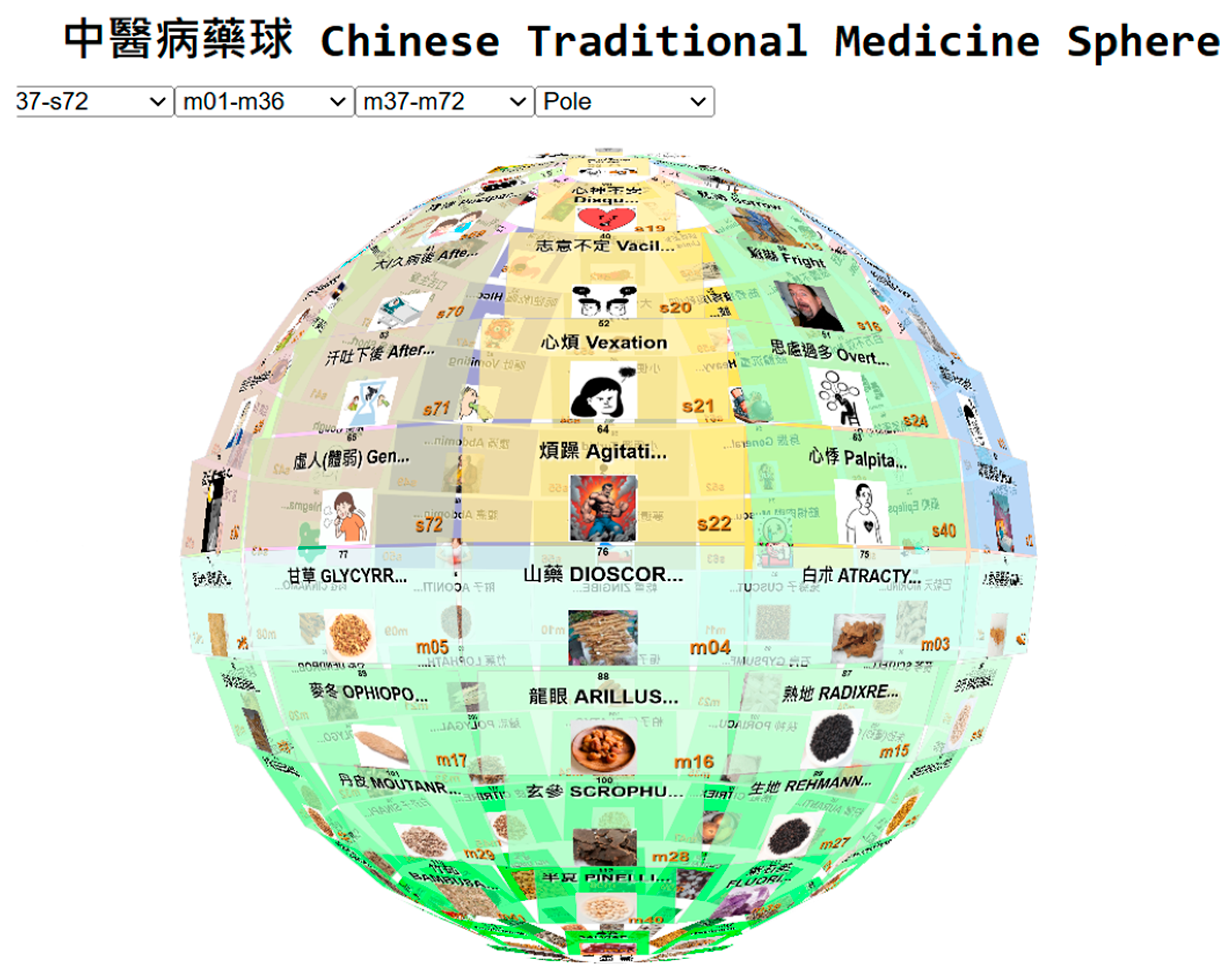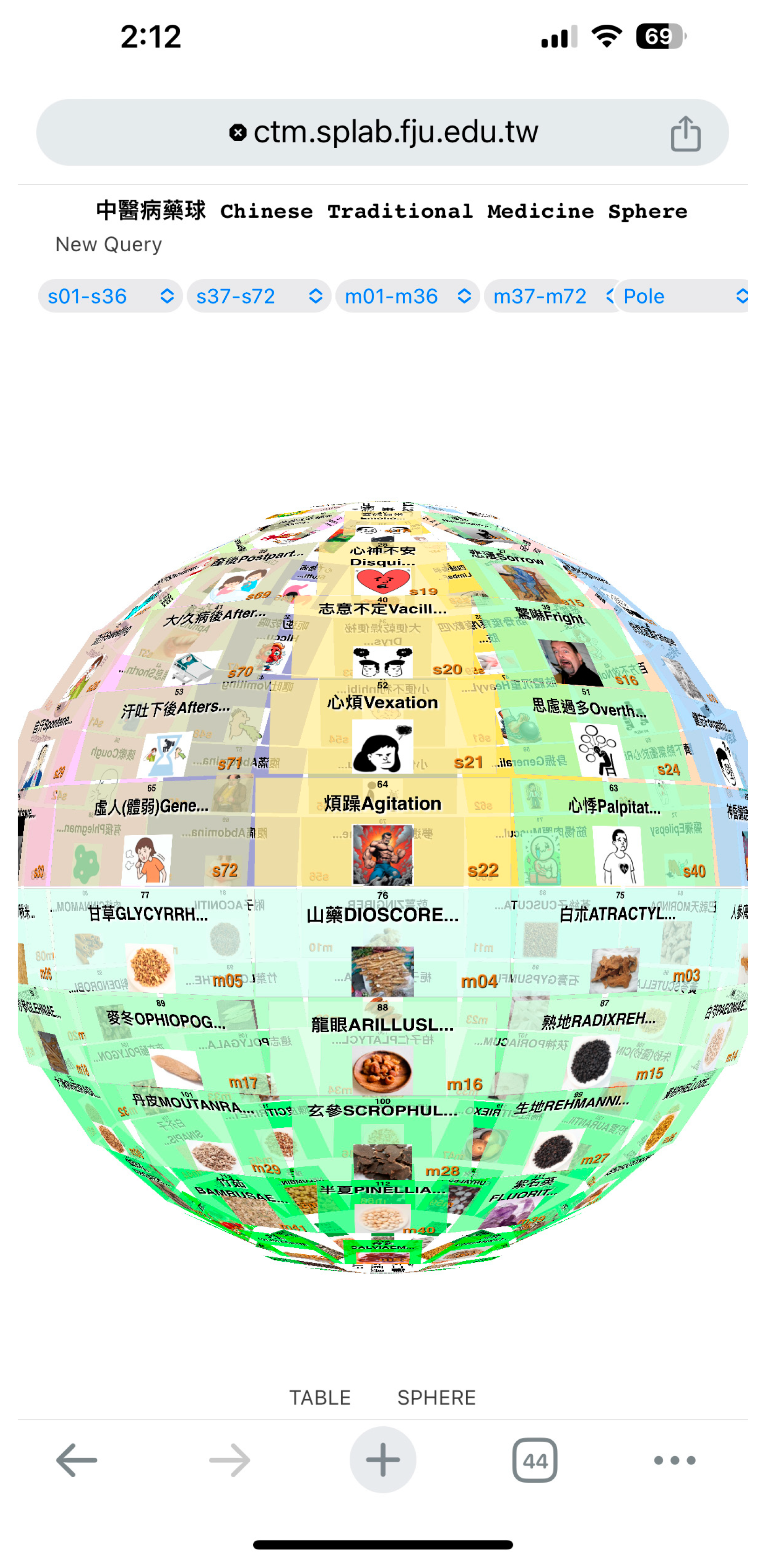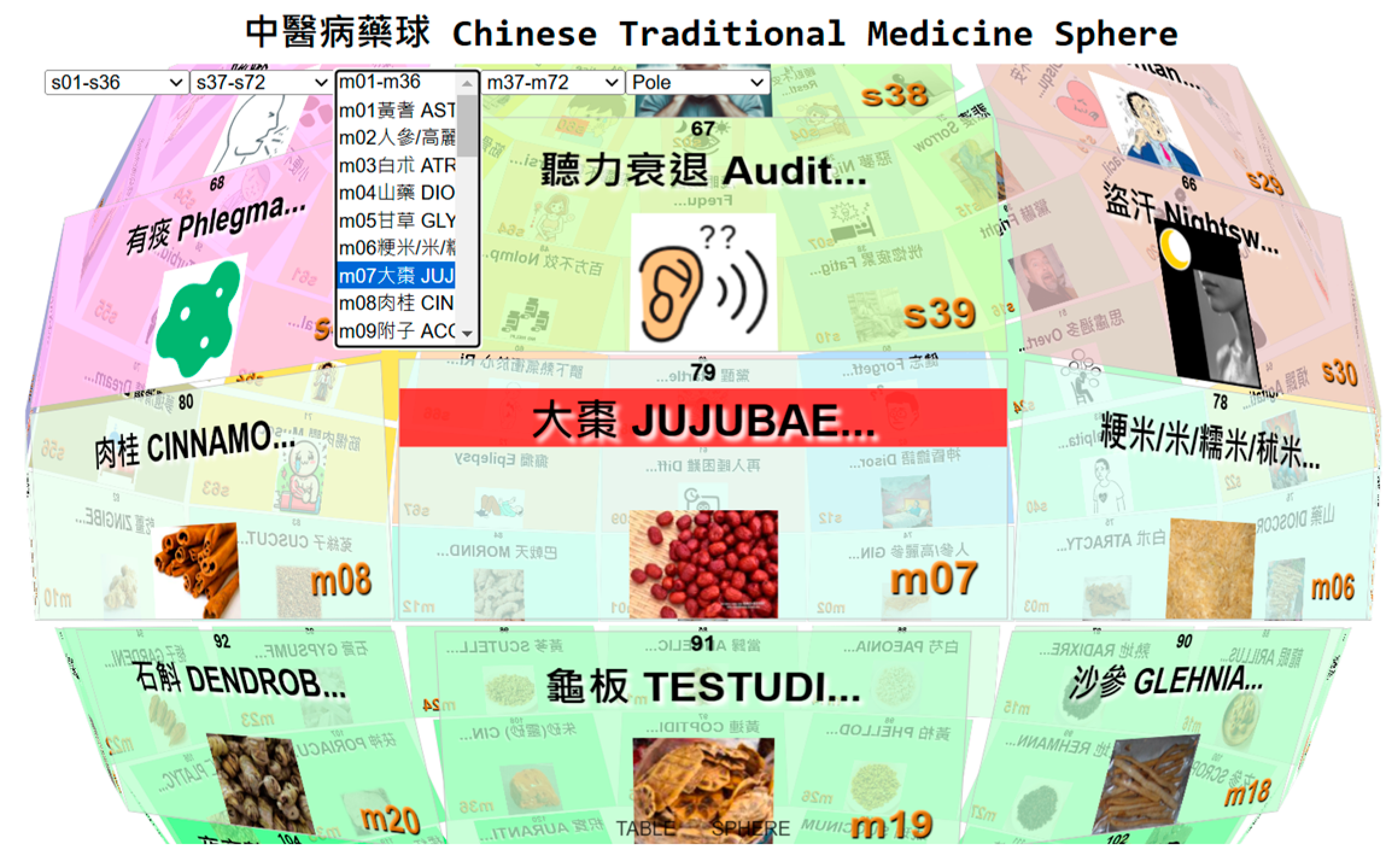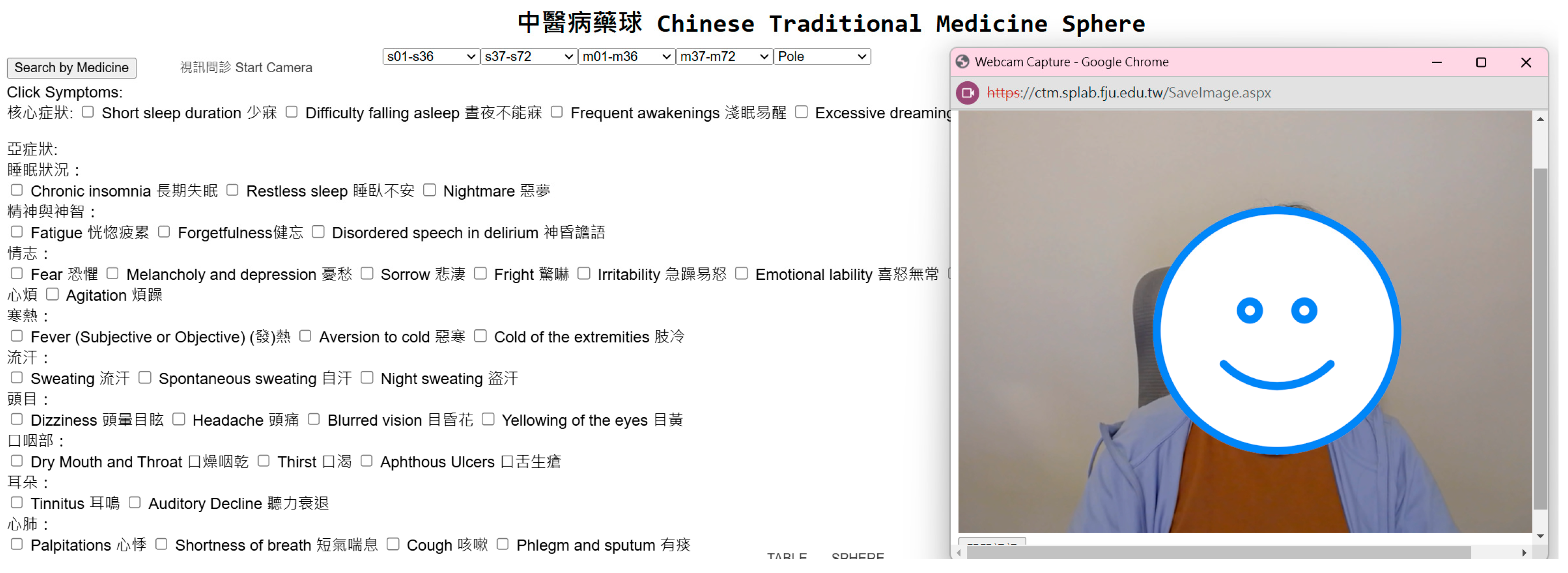1. Introduction
Insomnia is a common symptom in modern individuals. In adults over the age of 35, the one-year incidence of acute insomnia is 27%, with nearly 20% of patients experiencing persistent sleep disturbances. Chronic insomnia significantly impacts one’s quality of life, leading to impaired memory, lack of concentration, reduced work efficiency, emotional instability, and adverse effects on interpersonal relationships and social satisfaction. Chronic insomnia increases the risk of certain diseases and exacerbates the severity of existing conditions, including allergic diseases, asthma, cardiovascular diseases, metabolic syndrome, mental disorders, dementia, and sepsis [
1]. Given the prevalence of insomnia symptoms and their serious impact on health, effective insomnia treatment has become an important medical concern.
Many patients choose alternative therapies, especially traditional Chinese medicine (TCM), known for its holistic and constitution-nourishing approach, to treat insomnia. According to statistics, insomnia was most diagnosed among patients seeking treatment at the TCM Department of Taipei Veterans General Hospital in 2002 [
2]. The insurance database shows a gradual increase in the number of people seeking Chinese medicine treatment for insomnia from 2002 to 2004 [
1]. This indicates widespread attention among Taiwanese patients to the application of TCM in the treatment of insomnia.
Considering the diversity in the composition and application of Chinese herbal formulas used in TCM for treating insomnia, numerous studies have been conducted to clarify their efficacy and scope of application. For instance, Taipei City Hospital published a study summarizing Chinese herbal formulas used for treating insomnia in Taiwan from 2003 to 2006, as shown in
Table 1 [
3].
Table 1 provides statistical data on the most commonly used Chinese herbal medicines and formulas for insomnia, serving as a reference for clinical physicians. Although this data allows doctors to understand commonly used formulas, it does not delve into the relationship between different symptoms and the use of Chinese herbal formulas. Therefore, it does not provide individualized treatment approaches for different patients, nor does it comprehensively reflect the diversity of Chinese herbal formulas for treating insomnia. Additionally, there is a lack of an excellent retrieval system, and it does not visually present relevant information on TCM treatments for insomnia symptoms and medicines. To address the inefficiency of retrieval in
Table 1, we established a 3D visualized spherical retrieval system (SRS) to improve the efficiency of retrieving TCM symptoms and medicines. Furthermore, by creating a virtual reality sphere (VRS), the public’s learning interest in TCM can be increased in a novel and engaging way. This effort is related to the United Nations Sustainable Development Goal 4: Quality Education. Regardless of whether the users are TCM professionals or not, they can use the developed system to query information on TCM-related symptoms, corresponding Chinese medicines, and prescriptions.
2. Data Preprocessing
We selected 72 commonly used symptoms and 72 prescriptions from the insomnia prescription retrieval table in the Dictionary of TCM Formulas (
Table 2 and
Table 3) and encoded them. Subsequently, we established basic data tables for these symptoms and medicines and calculated their similarities in preparation for data clustering.
Before calculating the similarities, it is important to compute the common medicines between pairs of symptoms. The more common medicines there are, the more similar the two symptoms are. Given a set of medicines
and a set of symptoms
, the number of common medicines (i.e., co-occurrence medicines for a pair of symptoms) in the medicine set that can treat a pair of symptoms
s and
s′ is calculated using (1) [
4]. The computed results for common medicines are shown in
Table 4. The data in
Table 4 is then imported into the Orange software (Version 3.36.2) to cluster the 72 symptoms.
3. Symptom Clustering
The k-means algorithm was used to cluster the symptoms. The k-means algorithm uses a greedy approach to improve clustering quality and approach a local optimum [
5]. K-means is the most popular, simplest, and has low computational complexity among clustering algorithms [
6]. Johannes et al. applied clustering methods to human grouping, while we clustered methods using data segmentation [
7]. The purpose of clustering and solving in batches is to improve optimization efficiency and reduce the procurement and setup costs of computer hardware and software. We used the Orange software (
https://orangedatamining.com/, accessed on 1 November 2023) for clustering. The process includes (1). data import, (2). setting attributes and target fields, (3). creating training and testing data, (4). building models, (5). evaluating models, and (6). examining predicted results (
Figure 1) [
8].
We prepared a sphere with 144 grids. The 72 symptoms were divided into 3 clusters using the K-means algorithm and allocated to the upper hemisphere, while the lower hemisphere was allocated to the 72 medicines.
Figure 2 shows the K-means clustering results for cluster C1. C1 contains 11 symptoms. Each symptom was assigned to one grid. To accommodate these symptoms, they were divided into 2 columns, with each column containing 6 grids, resulting in a total of 2 × 6 = 12 grids.
The allocation results for the second cluster, C2, using K-means are shown in
Figure 3. C2 contains 43 symptoms. To accommodate these symptoms, 8 vertical columns are used, each containing 6 grids, resulting in a total of 8 × 6 = 48 grids.
The remaining symptoms that were not assigned to C1 and C2 were allocated to cluster C3. Thus, the allocation results of the symptoms on the upper hemisphere are shown in
Figure 4. Grids of the same color on the sphere indicate the same cluster. Symptoms that share common medicines have higher similarity, and those with higher similarity are more likely to be grouped. Symptoms s40, s16, and s21 have the highest number of common medicines and are indeed grouped. This demonstrates the high accuracy of using k-means clustering.
Although the clustering results are highly accurate, dividing the symptoms into only three clusters does not adequately reflect the detailed characteristics of the symptoms and the specific functions of the medicines. Therefore, TCM practitioners need to categorize the symptoms into 12 categories, with each category assigned to the same vertical column. This approach makes it easier to search for and intuitively understand the main functions and directions of the medicines. Consequently, we reclassified the symptoms and medicines according to the recommendations of TCM experts. Finally, on the sphere, different colored grids represent different categories of symptoms and medicines.
4. TCM Database
After determining the positions of all symptoms and medicines in the sphere, we established a comprehensive TCM database containing all the data. Basic data tables for symptoms, medicines, and prescriptions were created with tables for grid numbers and coordinates on the sphere. The relationship between these tables was established.
Figure 5 shows the snowflake schema diagram of the normalized relationships between the tables.
5. Retrieval System
After the TCM database was established, an online interactive SRS was created to help users query the corresponding medicines for TCM symptoms. This SRS uses technologies such as ASP.NET, JavaScript, Three.js, and Microsoft’s SQL Server. It is built on a three-tier architecture. Users can access the system via a computer, smartphone, or tablet. The system’s designed functions include the following: (1) query filtering based on symptoms or medicines; (2) zooming in and out and panning the sphere; (3) clicking on images on the sphere opens new pages with detailed information; (4) selecting a symptom from the dropdown menu to display the prescriptions for that symptom and rotating the sphere to position the symptom at the front center; (5) highlighting the relevant symptoms and corresponding medicines on the sphere in red when hovering the mouse over the menu, the hover function is triggered; and (6) visual analysis charts for prescriptions, such as word clouds and tree diagrams.
The URL for the completed TCM SRS is
https://ctm.splab.fju.edu.tw/Ctm.aspx (Accessed on 22 February 2025). The website interface is shown in
Figure 6. This URL automatically detects the access device, and if it is a mobile device (smartphone or tablet), the system automatically switches to the mobile version of the webpage. The mobile version interface is shown in
Figure 7.
Additionally, for the desktop version, we developed an interactive highlight function (Hover). When users move the cursor over a symptom or medicine in the menu, the corresponding medicine names and their related symptom numbers on the sphere indicate the symptoms treatable by that medicine. Similarly, when the cursor hovers over a symptom, the background color of the symptom and its corresponding medicine numbers turn red on the sphere. This highlight function received high praise from participants during the survey (
Figure 8).
The query interface design of this study allows users to find related medicines and prescriptions from symptoms or to find treatable symptoms from Chinese medicines. The query interface is shown in
Figure 9.
For consultations with patients in remote areas or those needing telemedicine, such as during the COVID-19 quarantine, we designed a telemedicine video consultation feature. Doctors need to click the “Video Consultation” button, and the system automatically activates the webcam. This allows TCM doctors to observe the patient’s complexion, examine their tongue, and inquire about their symptoms, as shown in
Figure 10.
6. VRS
To enhance user interaction and increase interest in TCM, we developed a TCM VRS that users can immerse in using VR glasses or head-mounted devices. The system was developed using the Oculus Unity SDK and is compatible with Meta Quest 3 devices. The designed features of the VRS are as follows.
6.1. Spherical Information Display
In a 3D VR environment, a 3D spherical structure and 144 information panels about TCM are constructed.
6.2. Dynamic Double-Sided Browsing
Based on the user’s position, whether inside or outside the sphere, the information panels dynamically adjust to display on the front or back, providing an optimal browsing experience.
6.3. Smart Dragging
Users can use the right-hand joystick and ray to drag information panels and rotate the sphere. To prevent the information panels from tilting or flipping during rotation, the sphere automatically aligns the selected information panel to an easy-to-read orientation, ensuring a smooth browsing experience.
6.4. Position and Size Adjustment
To allow users to browse and operate in their preferred way, the left-hand joystick can be used to adjust the sphere’s position and size. The left-hand joystick’s X button is used to set the sphere’s center position on the ground at the user’s feet, the Y button is used to set the sphere’s center at the front of the left-hand controller, and the left-hand joystick is used to scroll up and down to adjust the sphere’s size.
Figure 11 shows the development results and actual testing of the VR sphere. It includes a photo from one of the classes featuring the VRS experience. We involved a total of 4 classes where students engaged with the TCM VRS. Most students experienced VR for the first time and found the VRS extremely enjoyable. Students expressed interest in purchasing their own VR headsets, making it a perfect blend of education and entertainment.
7. Survey Result
We designed two types of questionnaires. The first questionnaire survey was carried out for professionals in TCM, students, and TCM doctors to gather their opinions on the TCM SRS and to conduct tests. A total of 38 questionnaire responses were received [
1]. The second questionnaire survey was conducted for students majoring in information systems and interdisciplinary English programs, including three international students, office workers, and IT professionals. The 12 survey questions are shown in
Table 5. We provided on-site demonstrations and operations of the SRS and VRS, allowing the participants to experience the systems and compare them with traditional 2D table queries. Finally, the participants filled out a 12-question feedback questionnaire. A total of 66 valid responses were received.
A total of 41 students accounted for 61% of the number of participants. A total of 11 (17%) were industrial and commercial staff. Five teachers accounted for 8%.
We conducted a student’s
t-test to compare the significance between two sets of data using TCM SRS and TCM Prescription Dictionary 2D Tables. The
t-test results for Question 10, “TCM Sphere is easier than TCM Prescription Dictionary 2D Tables to find corresponding Chinese medicine and prescriptions (formulas) for insomnia symptoms”, and Question 11, “I find TCM Sphere more interesting and enjoyable than TCM Prescription Dictionary 2D Tables”, were a t-statistic of −3.110 and a
p-value of 0.002. This indicates a significant difference in the evaluations between using TCM SRS and TCM Prescription Dictionary 2D Tables, as the
p-value is less than 0.05. The null hypothesis was rejected, meaning the means between the two are different. These results suggested that participants perceived a significant difference in the ease of finding corresponding Chinese medicine and prescriptions (formulas) for insomnia symptoms and in the level of interest and enjoyment, favoring TCM SRS. The survey results for the 12 questions are shown in
Table 6.
In addition, interview results with TCM practitioners and professionals revealed that the SRS and VRS developed in this study serve as tools to assist TCM students in their studies, stimulating their interest in learning. However, due to differences between the medication sources and those currently in use, adjustments are needed for clinical application. Future system filtering using “AND” aligns with physicians’ prescribing habits [
1]. Additionally, TCM practitioners suggested that the VRS is interesting and recommended adding a feature for “synchronous consultation between physician and patient in a VR environment” to expand its applicability.
8. Conclusions
To address the challenge of retrieving information from 2D tables, we developed the TCM SRS. The TCM SRS is more user-friendly for finding symptoms corresponding to medications compared to traditional 2D tables. Additionally, to promote TCM knowledge, we introduced the VRS. VRS increases public and student interest and contributes to sustainable development.
Author Contributions
Conceptualization, C.-H.S. and G.-H.L.; methodology, C.-H.S.; software, C.-H.S. and T.-A.F.; validation, T.-A.F. and C.-H.S.; formal analysis, T.-A.F. and C.-H.S.; investigation, T.-A.F. and C.-H.S.; resources, G.-H.L. and C.-H.S.; data curation, T.-A.F.; writing—original draft preparation, C.-H.S. and T.-A.F.; writing—review and editing, C.-H.S., G.-H.L. and T.-A.F.; visualization, C.-H.S. and T.-A.F.; supervision, C.-H.S. and G.-H.L.; project administration, C.-H.S. and G.-H.L.; funding acquisition, C.-H.S. and G.-H.L. All authors have read and agreed to the published version of the manuscript.
Funding
This research was supported by the National Science and Technology Council, grant number NSTC 112-2410-H-030-099.
Institutional Review Board Statement
This study received approval from the Institutional Review Board (IRB) of the Chang Gung Medical Foundation (Approval No. 202400566B0).
Informed Consent Statement
Not applicable.
Data Availability Statement
No new data were created or analyzed in this study. Data sharing is not applicable to this article.
Acknowledgments
We thank Han-Lin Li and Ching-Ter Chang for their expert advice and guidance on the spherical search system.
Conflicts of Interest
The authors declare no conflicts of interest. The funders had no role in the design of the study; in the collection, analyses, or interpretation of data; in the writing of the manuscript; or in the decision to publish the results.
References
- Fan, T.-A. Graduate Institute of Traditional Chinese Medicine. Master’s Thesis, Chang Gung University, Taoyuan, Taiwan, 2024. [Google Scholar]
- Chen, L.C.; Wang, B.R.; Chou, Y.C.; Tien, J.H. Drug utilization pattern of Chinese herbal medicines in a general hospital in Taiwan. Pharmacoepidemiol. Drug Saf. 2005, 14, 651–657. [Google Scholar] [PubMed]
- Chen, L.C.; Chen, I.C.; Wang, B.R.; Shao, C.H. Drug-use pattern of Chinese herbal medicines in insomnia: A 4-year survey in Taiwan. J. Clin. Pharm. Ther. 2009, 34, 555–560. [Google Scholar] [PubMed]
- Li, H.-L.; Shih, C.-H.; Hu, C.-C.; Yang, C. Forming a Therapeutic sphere to treat ailments using optimization techniques. Int. Trans. Oper. Res. 2022, 30, 3949–3978. [Google Scholar] [CrossRef]
- Han, J.; Kamber, M.; Pei, J. Data Mining: Concepts and Techniques, A Volume in The Morgan Kaufmann Series in Data Management Systems, 3rd ed.; Elsevier eBook: Amsterdam, The Netherlands, 2012. [Google Scholar] [CrossRef]
- Ikotun, A.-M.; Ezugwu, A.-E.; Abualigah, L.; Abuhaija, B.; Heming, J. K-means clustering algorithms: A comprehensive review, variants analysis, and advances in the era of big data. Inf. Sci. 2023, 622, 178–210. [Google Scholar] [CrossRef]
- Johannes, K.; Jürgen, Z. A comparative study of item space visualizations for recommender systems. Int. J. Hum.-Comput. Stud. 2023, 172, 102987. [Google Scholar] [CrossRef]
- Shih, C.H.; Chang, C.T. Constructing renewable energy sphere for efficient search. J. Clean. Prod. 2024, 471, 143412. [Google Scholar]
| Disclaimer/Publisher’s Note: The statements, opinions and data contained in all publications are solely those of the individual author(s) and contributor(s) and not of MDPI and/or the editor(s). MDPI and/or the editor(s) disclaim responsibility for any injury to people or property resulting from any ideas, methods, instructions or products referred to in the content. |
© 2025 by the authors. Licensee MDPI, Basel, Switzerland. This article is an open access article distributed under the terms and conditions of the Creative Commons Attribution (CC BY) license (https://creativecommons.org/licenses/by/4.0/).


